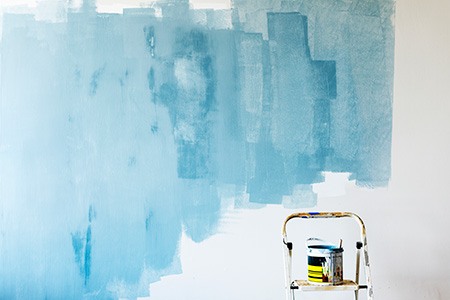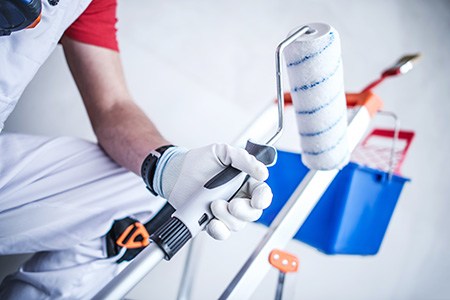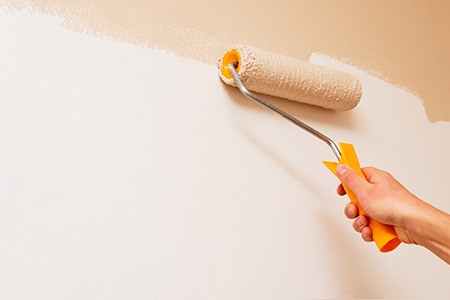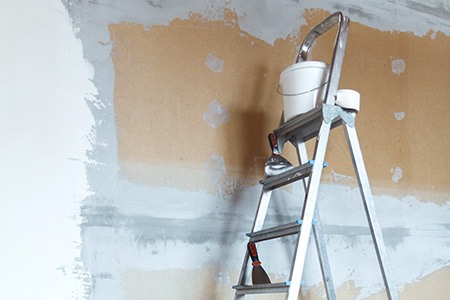Can You Use Exterior Paint Inside? Yes, But Should You?
Author: Omar Alonso | Editor: Omar Alonso
Review & Research: Jen Worst & Chris Miller

When it comes to selecting the right paint for your home, making an informed decision is crucial. Many people often wonder: can you use exterior paint inside?
The short answer is that while exterior and interior paints share some similarities in composition and color application, using exterior paint indoors could have potential risks due to harmful chemicals.
Here we will delve into the differences between these two types of paints, explore the pros and cons of using exterior paint inside, and provide guidance on when such usage may be appropriate.
Understanding the Differences Between Exterior & Interior Paint
Interior and exterior paint differ in composition, with interior paint being formulated for easy cleaning, while exterior paints have a higher level of durability to withstand harsh weather conditions.
Composition

Understanding the differences in composition between interior and exterior paint is crucial when deciding which type to use for a specific project. The primary distinction lies in the type of resin and additives present in each formulation. This is a similar question to using ceiling paint on walls, with a similar answer.
Exterior paints contain resins that provide greater flexibility and adhesion, allowing them to expand and contract with fluctuating temperatures without cracking or peeling.
On the other hand, interior paints utilize vinyl-acrylic or alkyd resins, which are more suitable for providing a smooth finish on indoor surfaces. In addition to the selection of resin, various additives play a significant role in determining how well a paint will perform indoors versus outdoors.
For instance, exterior paint may include mildewcides to prevent mold growth, while interior paint might have less abrasive additives like flame retardants and low VOCs (volatile organic compounds) for better air quality inside your home. Exterior paint may dry darker or lighter than expected since it won't have the same exposure to the sun that can discolor it over time.
Durability
Understanding the differences between exterior and interior paint is essential when it comes to durability. Exterior paints are specifically designed to withstand harsh outdoor elements such as wind, rain, and fluctuating temperatures.
On the flip side, interior paints do not contain these added components and should not be used outdoors due to their inability to endure external factors. In terms of composition, acrylic paints are more durable than latex ones and can better tolerate temperature changes.
Besides that, exterior paint releases volatile organic compounds (VOCs), which pose health risks when used indoors. Can you use outdoor paint inside? Yes, but keep this factor in mind.
Appearance

Can you use exterior paint inside? Yes, but a significant factor that distinguishes exterior and interior paint is their appearance. The chemical composition of the paint formulations is specifically tailored to meet the unique demands of outdoor and indoor environments, resulting in some notable visual differences between the two types.
Exterior paints are crafted with weather resistance in mind, using non-organic pigments that provide long-lasting color retention despite constant exposure to harsh elements such as sunlight, rain, and temperature changes.
On the other hand, interior paints utilize organic pigments which produce more vivid colors with a broader range of finishes available - from matte to glossy sheens.
These hues are specifically designed for indoor use where lighting conditions may vary greatly compared to outdoors; thus, providing an aesthetically pleasing visual impact inside your living spaces without compromising on safety or air quality concerns – thanks to their milder odors.
Risks & Benefits of Using Exterior Paint Inside
Exterior paint can contain toxic fumes that are harmful to indoor air quality, yet it may be useful for repurposing outdoor furniture or rooms with high moisture levels.
Toxic Fumes & Poor Indoor Air Quality
Using exterior paint indoors can pose serious health risks due to the release of toxic fumes and poor indoor air quality. This is because exterior paints contain high levels of volatile organic compounds (VOCs) that are released into the air as the paint dries.
Exposure to these toxic chemicals in enclosed spaces can lead to various health problems such as headaches, nausea, respiratory issues, and even long-term effects like cancer or damage to the central nervous system.
It's important to prioritize safer options for indoor use by choosing low-VOC or zero-VOC paints that produce fewer harmful emissions but still offer a wide range of finishes and easy maintenance. Make sure you wait the appropriate amount of time to sleep in a room you've just painted.
Repurposing Outdoor Furniture
Repurposing outdoor furniture is becoming increasingly popular among homeowners who want to save money and reduce waste. If you plan to use your outdoor furniture inside, it's important to choose the right type of paint that can withstand both indoor and outdoor conditions.
While exterior paints are formulated for long-lasting protection against harsh weather elements, they may not be safe for indoor use due to their high levels of VOC emissions that can pose a risk to respiratory health.
It's crucial to opt for low-VOC or zero-VOC interior paint formulations if you plan on using repurposed furniture or any object indoors.
When the Room Needs to Withstand High Humidity or Moisture

Can you use exterior paint inside? Yes, and sometimes it's the right decision. For instance, high humidity and moisture can cause problems for interior painting projects. If your room is prone to moisture, it's important to choose the right paint that can withstand these conditions.
Bathrooms are a prime example of where this would be necessary due to high levels of steam caused by showers and baths. Moisture-resistant paint is specifically designed for areas with excess moisture and can help prevent mold growth, peeling, and cracking.
This type of paint has additives like mildewcide or fungicide that fight against mold spores before they start growing on your walls. Basement waterproofing projects also require special consideration when choosing the right paint due to increased likelihood for water intrusion into the space.
Safer & Healthier Options for Indoor Use
To avoid the health risks associated with using exterior paint inside, it is important to choose safer and healthier options for indoor use. Low-VOC or zero-VOC paints are a great alternative to traditional paints as they contain fewer harmful chemicals that can affect indoor air quality.
Natural paints made from ingredients like clay and lime are also gaining popularity due to their eco-friendliness and non-toxic properties. Milk paint is another option that has been used for centuries and consists of natural ingredients such as milk protein, lime, clay, and pigments.
Easier Maintenance & Wider Range of Finishes
When it comes to the maintenance of painted surfaces, exterior paint tends to be softer and easier to care for than interior paint. The ability of exterior paints to adjust to temperature and environmental extremes makes them ideal for outdoor use, but also means they are less prone to cracking or fading indoors.
Another advantage of using exterior paint is the wider range of finishes available. While interior paints often come in flat, eggshell, satin, and gloss finishes; exterior paints can include additional options such as semi-gloss or high-gloss.
This variety can help homeowners achieve a specific look or texture they desire on their indoor surfaces.
When Is it Okay to Use Exterior Paint Inside?

It is okay to use exterior paint inside only when no other types of paint are available, or when the room needs to withstand high humidity or moisture. So, can exterior paint be used inside? Yes, and here's when.
When No Other Paint Is Available
While it is not ideal, using exterior paint inside may be necessary when no other paint options are available and you don't want to opt for any paint alternatives to interior walls. For example, if a room urgently needs to be painted and the only paint on hand is exterior, it can be used as a temporary solution.
However, keep in mind that the finish may not be as desirable for indoor use and there could be potential health risks associated with toxic fumes. It’s important to prioritize safety and proper ventilation when using exterior paint indoors.
When the Room Needs to Withstand High Humidity or Moisture
If you're painting a room that's prone to high humidity or moisture, using exterior paint could be a viable option. Exterior paints are formulated with stronger chemicals and additives, making it more resistant to water damage than interior paint.
This makes it ideal for rooms like bathrooms or basements that have higher levels of moisture in the air. Additionally, if repurposing furniture that will be used outside, applying exterior paint can help protect against rain and other elements.
However, when using exterior paint indoors, make sure to ventilate the area thoroughly as this type of paint emits harmful fumes that can affect indoor air quality.
When Repurposing an Object or Furniture for Outdoor Use
Repurposing outdoor furniture for indoor use is a great way to save money and add character to your home. However, it's important to choose the right paint if you want your repurposed item to last.
Exterior paint can be a good option in this case since it's designed to withstand harsh weather conditions and frequent exposure to sunlight. Just keep in mind that exterior paints contain more harmful chemicals than their indoor counterparts, so make sure to adequately ventilate the area during application and drying.
Key Takeaways for Using Exterior Paint Inside

- Exterior paint should not be used indoors due to potentially harmful chemicals and VOC emissions that can affect indoor air quality.
- Interior and exterior paints differ in composition, durability, and appearance, with interior paint being formulated for easy cleaning while exterior paints have a higher level of durability to withstand harsh weather conditions.
- It's important to choose safer and healthier options for indoor use like low-VOC or zero-VOC paints that produce fewer harmful emissions but still offer a wide range of finishes. Natural paints made from ingredients like clay and lime are also gaining popularity due to their eco-friendliness and non-toxic properties.
- While it is okay to use exterior paint inside when no other types of paint are available or when the room needs to withstand high humidity or moisture, proper ventilation during application and drying is crucial. However, it's always best to prioritize safety by choosing the correct type of paint formulation for your project.
So, Can You Use Exterior Paint Inside?
In conclusion, while the color application of exterior and interior paint is the same, it's not recommended to use exterior paint indoors. This is because of its potentially harmful chemicals that can cause respiratory problems and worsen existing conditions.
It's always best to opt for safer options when it comes to indoor painting projects. If you must use exterior paint inside, do so sparingly and ensure proper ventilation while painting.
Remember that using safer paints will guarantee easier maintenance, wider range of finishes, and better overall health for you and your family. So can you use exterior paint inside? Yes, with care.



